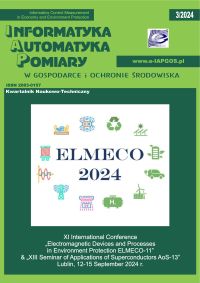[1] Akour I. et al.: Using machine learning algorithms to predict people’s intention to use mobile learning platforms during the COVID-19 pandemic: machine learning approach. JMIR Medical Education 7, 2021, e24032.
DOI: https://doi.org/10.2196/24032
[2] Altabrawee H., Ali O. A. J., Ajmi S. Q.: Predicting students’ performance using machine learning techniques. Journal of University of Babylon for pure and applied sciences 27, 2019, 194–205.
DOI: https://doi.org/10.29196/jubpas.v27i1.2108
[3] Aman F. et al.: A predictive model for predicting students academic performance. 10th International Conference on Information, Intelligence, Systems and Applications – IISA. IEEE, 2019, 1–4.
DOI: https://doi.org/10.1109/IISA.2019.8900760
[4] Arnold K. E., Pistilli M. D.: Course signals at Purdue: Using learning analytics to increase student success. 2nd International Conference on Learning Analytics and Knowledge, 2012, 267–270.
DOI: https://doi.org/10.1145/2330601.2330666
[5] Baraniuk R.: Open education: New opportunities for signal processing. IEEE International Conference on Acoustics, Speech and Signal Processing – ICASSP, 2015.
[6] Bhardwaj B. K., Pal S.: Data Mining: A prediction for performance improvement using classify cation. arXiv preprint arXiv:1201.3418, 2012.
[7] Bhutto E. S. et al.: Predicting students’ academic performance through supervised machine learning. International Conference on Information Science and Communication Technology – ICISCT. IEEE, 2020, 1–6.
DOI: https://doi.org/10.1109/ICISCT49550.2020.9080033
[8] Borge N.: Artificial intelligence to improve education/learning challenges. International Journal of Advanced Enginering & Innovative Technology – IJAEIT 2, 2016, 10–13.
[9] Chaudhury P. et al.: Enhancing the capabilities of student result prediction system. Second International Conference on Information and Communication Technology for Competitive Strategies, 2016, 1–6.
DOI: https://doi.org/10.1145/2905055.2905150
[10] Clow D.: An overview of learning analytics. Teaching in Higher Education 2013, 18, 683–695.
DOI: https://doi.org/10.1080/13562517.2013.827653
[11] Ever Y. K., Dimililer K.: The effectiveness of a new classification system in higher education as a new e-learning tool. Quality & Quantity 52, 2018, 573–582.
DOI: https://doi.org/10.1007/s11135-017-0636-y
[12] Gray G., McGuinness C., Owende P.: An application of classification models to predict learner progression in tertiary education. IEEE International Advance Computing Conference – IACC. IEEE, 2014, 549–554.
DOI: https://doi.org/10.1109/IAdCC.2014.6779384
[13] Huang S., Fang N.: Work in progress: Early prediction of students’ academic performance in an introductory engineering course through different mathematical modeling techniques. Frontiers in Education Conference Proceedings. IEEE, 2012, 1–2.
DOI: https://doi.org/10.1109/FIE.2012.6462242
[14] Kolo D. K., Adepoju S. A., Alhassan J. K.: A decision tree approach for predicting students academic performance. I.J. Education and Management Engineering 5, 2015, 12–19.
DOI: https://doi.org/10.5815/ijeme.2015.05.02
[15] Kotsiantis S. B.: Use of machine learning techniques for educational proposes: a decision support system for forecasting students’ grades. Artificial Intelligence Review 37, 2012, 331–344.
DOI: https://doi.org/10.1007/s10462-011-9234-x
[16] Mueen A., Zafar B., Manzoor U.: Modeling and Predicting Students’ Academic Performance Using Data Mining Techniques. International Journal of Modern Education & Computer Science 8, 2016.
DOI: https://doi.org/10.5815/ijmecs.2016.11.05
[17] Osmanbegovic E., Suljic M.: Data mining approach for predicting student performance. Economic Review: Journal of Economics and Business 10, 2012, 3–12.
[18] Oyedeji A. O. et al.: Analysis and prediction of student academic performance using machine learning. JITCE (Journal of Information Technology and Computer Engineering) 4, 2020, 10–15.
DOI: https://doi.org/10.25077/jitce.4.01.10-15.2020
[19] Rachburee N., Punlumjeak W.: A comparison of feature selection approach between greedy, IG-ratio, Chi-square, and mRMR in educational mining. 7th International Conference on Information Technology and Electrical Engineering – ICITEE. IEEE, 2015, 420–424.
DOI: https://doi.org/10.1109/ICITEED.2015.7408983
[20] Romero C., Ventura S.: Educational data mining: A survey from 1995 to 2005. Expert systems with applications 33, 2007, 135–146.
DOI: https://doi.org/10.1016/j.eswa.2006.04.005
[21] Said M. A., Idris M., Hussain S.: Relationship between Social Behaviour and Academic Performance of Students at Secondary Level in Khyber Pakhtunkhwa. Pakistan Journal of Distance and Online Learning 4, 2018, 153–170.
[22] Sekeroglu B., Dimililer K., Tuncal K.: Student performance prediction and classification using machine learning algorithms. 8th International Conference on Educational and Information Technology, 2019, 7–11.
DOI: https://doi.org/10.1145/3318396.3318419
[23] Singh A., Halgamuge M. N., Lakshmiganthan R.: Impact of different data types on classifier performance of random forest, naive bayes, and k-nearest neighbors algorithms. International Journal of Advanced Computer Science and Applications 8, 2017.
DOI: https://doi.org/10.14569/IJACSA.2017.081201
[24] Thammasiri D. et al.: A critical assessment of imbalanced class distribution problem: The case of predicting freshmen student attrition. Expert Systems with Applications 41, 2014, 321–330.
DOI: https://doi.org/10.1016/j.eswa.2013.07.046
[25] Wolff A. et al.: Developing predictive models for early detection of at-risk students on distance learning modules. LAK Workshops, 2014.







